An ordnance trailer is parked in front of two F-16C Fighting Falcon fighter aircraft of the 614th Tactical Fighter Squadron, 401st Tactical Fighter Wing, Torrejon Air Base, Spain, armed with bombs and AIM-9 Sidewinder air-to-air missiles, as they are prepared for a mission during gulf war Operation Desert Storm. At right are three Coalition F-1C Mirage fighter aircraft.
A Fighter Squadron 32 (VF-32) F-14A Tomcat aircraft, foreground, flies a joint patrol with a British Royal Air Force FGR. Mark 2 Phantom II aircraft during gulf war. The VF-42 Tomcat aircraft is based aboard the aircraft carrier USS JOHN F. KENNEDY (CV-67).
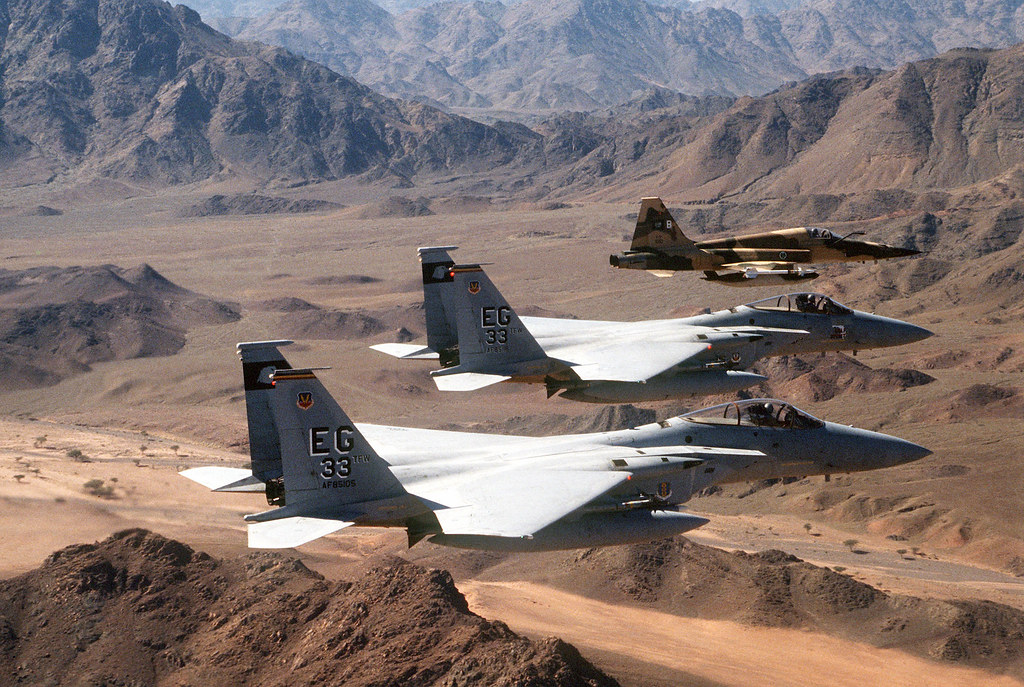 An air-to-air view of two U.S. Air Force F-15C Eagle fighter aircraft of the 33rd Tactical Fighter Wing, Eglin Air Force Base, Fla., and a Royal Saudi Air Force F-5E Tiger II fighter aircraft during a mission in support of gulf war. The aircraft are armed with AIM-9 Sidewinder air-to-air missiles.
An air-to-air view of two U.S. Air Force F-15C Eagle fighter aircraft of the 33rd Tactical Fighter Wing, Eglin Air Force Base, Fla., and a Royal Saudi Air Force F-5E Tiger II fighter aircraft during a mission in support of gulf war. The aircraft are armed with AIM-9 Sidewinder air-to-air missiles.
 An air-to-air view of two U.S. Air Force F-15C Eagle fighter aircraft of the 33rd Tactical Fighter Wing, Eglin Air Force Base, Fla., and a Royal Saudi Air Force F-5E Tiger II fighter aircraft during a mission in support of gulf war. The aircraft are armed with AIM-9 Sidewinder air-to-air missiles.
An air-to-air view of two U.S. Air Force F-15C Eagle fighter aircraft of the 33rd Tactical Fighter Wing, Eglin Air Force Base, Fla., and a Royal Saudi Air Force F-5E Tiger II fighter aircraft during a mission in support of gulf war. The aircraft are armed with AIM-9 Sidewinder air-to-air missiles.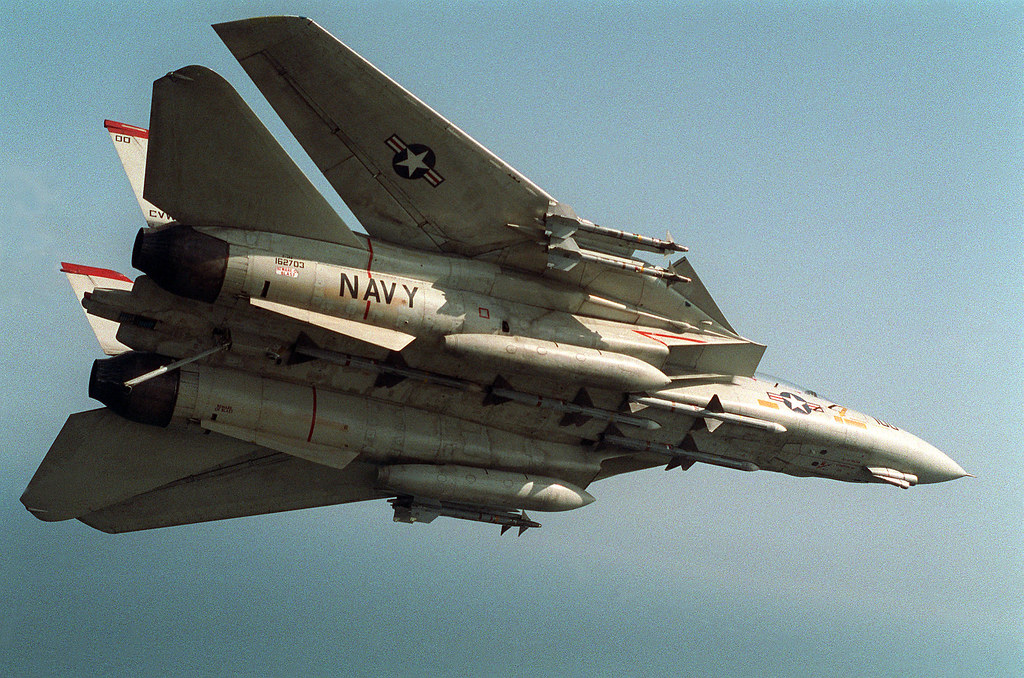 An underside view of a Fighter Squadron 41 (VF-41) F-14A Tomcat aircraft on a Combat Air Patrol (CAP) during Operation Desert Storm gulf war. The aircraft is carrying four AIM-7 Sparrow missiles under its fuselage and two AIM-9 Sidewinder missiles on each wing pylon.
An underside view of a Fighter Squadron 41 (VF-41) F-14A Tomcat aircraft on a Combat Air Patrol (CAP) during Operation Desert Storm gulf war. The aircraft is carrying four AIM-7 Sparrow missiles under its fuselage and two AIM-9 Sidewinder missiles on each wing pylon.
Three Fighter Squadron 32 (VF-32) F-14A Tomcat aircraft fly in formation over the desert during gulf war. VF-32 is based aboard the aircraft carrier USS JOHN F. KENNEDY (CV-67).

Sgt. Ken Mahaley, crew chief, 17th Avionics Squadron, launches an F-16C Fighting Falcon fighter aircraft of the 363rd Tactical Fighter Wing, Shaw Air Force Base, S.C., during the first wave of the air attack on Iraq in support of Operation Desert Storm. The Falcon is armed with Mark 84 2,000-pound bombs mounted under its wings.

Capt. Chris Castleberry, a pilot from the 421st Tactical Fighter Squadron, gives the thumbs up signal from the cockpit of his F-16C Fighting Falcon aircraft as he prepares for takeoff during gulf war

An air-to-air view of a multinational group of fighter jets, including, left to right, a Qatari F-1 Mirage, a French F-1C Mirage, a U.S. Air Force F-16C Fighting Falcon from the 401st Tactical Fighter Wing, a Canadian CF/A-18A Hornet and a Qatari Alpha Jet, during Operation Desert Shield.

A ground crew member signals to the pilot of a 614th Tactical Fighter Squadron F-16C Fighting Falcon aircraft as it prepares to takeoff on the first daylight strike against Iraqi targets during Operation Desert Storm.

A B-52G Stratofortress bomber aircraft of the 1708th Bomb Wing takes off on a mission during Operation Desert Storm.
Members of the 4th Weapons Squadron load SUU-65/B tactical munition dispensers onto an aircraft as they ready it for a mission during Operation Desert Shield.

A Kuwaiti Mirage 2000C fighter aircraft takes off for an air strike against Iraqi targets in support of Operation Desert Storm.

A 1st Tactical Fighter Wing F-15C Eagle aircraft refuels from a KC-135R Stratotanker aircraft while on a combat patrol near the Iraqi border during Operation Desert Shield.

U.S. Marine Corps F/A -18C Hornet strike-fighter jet from Marine Fighter-Attack Squadron 212 (VMFA-212), Kaneohe Marine Corps Air Base, Hawaii, fly in formation during Operation Desert Shield.

A Royal Saudi Air Force F-15 Eagle fighter jet approaches a KC-135 Stratotanker from the 1700th Air Refueling Squadron Provisional for refueling during Operation Desert Shield.

EF-111A Raven aircraft prepare to takeoff on a mission during Operation Desert Shield.

Munitions specialists from the 23rd Tactical Fighter Wing, England Air Force Base, La., load an AGM-65 Maverick air-to-surface missile onto an A-10A Thunderbolt II attack aircraft prior to a sortie in support of Operation Desert Storm.
An F-16C Fighting Falcon fighter aircraft from the 388th Tactical Fighter Wing, Hill Air Force Base, Utah, is prepared for a strike against targets in Iraq and Kuwait during Operation Desert Storm
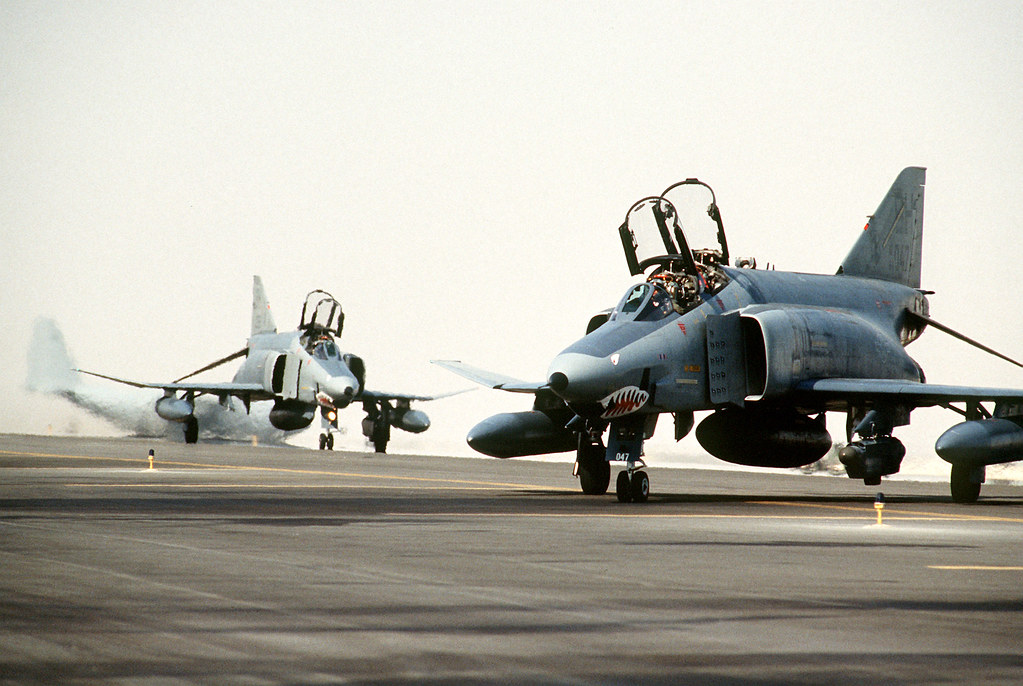
RF-4C Phantom reconnaissance aircraft from the 152nd Tactical Reconnaissance Group, Reno, Nev., prepare for a mission during Operation Desert Shield.
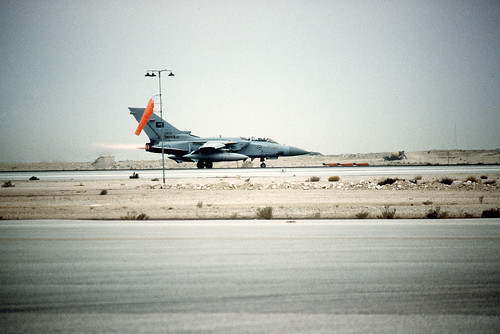
A Saudi Arabian Tornado aircraft takes off on a mission during Operation Desert Storm.
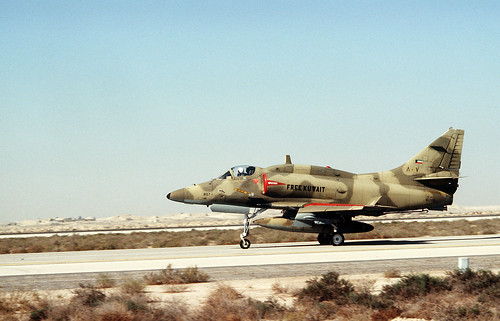
A Kuwaiti pilot taxies an A-4 Skyhawk attack aircraft toward the runway during Operation Desert Shield. Severed from its leadership and attacked where it lived, the Iraqi
Air Force (IQAF) was largely preempted from fighting. Those few
pilots who did go aloft did not fare well. Capt Steve Tate, the flight
leader of four F-15s from the 1st Tactical Fighter Wing, saw solid
streams of tracers over Baghdad—arcing like colored snakes—with
bombs going off everywhere. An E-A AWACS aircraft warned him
of an Iraqi Mirage F-1, which had just taken off and was closing on
the four Eagles from astern. He broke hard, turned behind the Mirage,
fired an AIM-7 Sparrow, and watched it track the Iraqi fighter, which
disintegrated in a huge fireball—one of 35 Iraqi aircraft that
eventually fell to American and Saudi fighters. With runways cratered
and many aircraft destroyed as ground crews readied them for flight,
Iraqi commanders chose to keep their remaining planes sealed in
bunkers, safe until they could be used at a moment of Iraq’s own
choosing. Thus, the IQAF never really got into the air



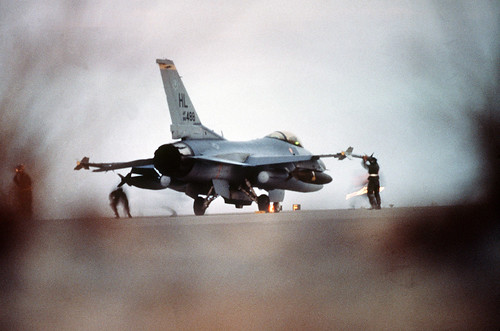




0 comments:
Post a Comment